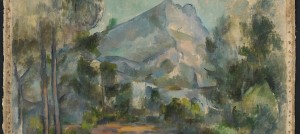 In November 2013, the Gurlitt saga propelled the complex historical and legal issues around looted art into the spotlight. It created, perhaps for the first time, an awareness for the importance of provenance research within the wider public. However, with Cornelius Gurlitt entering into an agreement with the Federal Republic of Germany and the State of Bavaria in April 2014 and his death shortly thereafter, on 6 May 2014, the matter has disappeared from the headlines. The opening of the exhibitions in Bonn and Berne in autumn last year brought the topic back at least to the art pages. Behind the scenes, the provenance research into the artwork in the good estate continues, but rarely gets publicity. Yesterday was an exception: Frankfurter Allgemeine reported that the Berne Museum of Fine Arts and the estate of Paul Cézanne had reached an agreement on Cézanne’s 1897 painting “La Montagne Sainte-Victoire”, arguably the commercially most valuable painting in the Gurlit collection. Read More
In November 2013, the Gurlitt saga propelled the complex historical and legal issues around looted art into the spotlight. It created, perhaps for the first time, an awareness for the importance of provenance research within the wider public. However, with Cornelius Gurlitt entering into an agreement with the Federal Republic of Germany and the State of Bavaria in April 2014 and his death shortly thereafter, on 6 May 2014, the matter has disappeared from the headlines. The opening of the exhibitions in Bonn and Berne in autumn last year brought the topic back at least to the art pages. Behind the scenes, the provenance research into the artwork in the good estate continues, but rarely gets publicity. Yesterday was an exception: Frankfurter Allgemeine reported that the Berne Museum of Fine Arts and the estate of Paul Cézanne had reached an agreement on Cézanne’s 1897 painting “La Montagne Sainte-Victoire”, arguably the commercially most valuable painting in the Gurlit collection. Read More
Tag: Hildebrand Gurlitt
Munich Court of Appeals: Berne Museum of Fine Arts Confirmed as Gurlitt’s Heir
 In November 2013, the Munich Art Find made headlines world wide, when a newsmagazine broke the story about the seizure of an art collection in the apartment of Cornelius Gurlitt, the son of Hildebrand Gurlitt, a privileged art dealer in the Nazi period. With the help of some guest authors, we have covered the story and some of its legal implications quite extensively on this blog.* Things have been quiet recently, but today, the Court of Appeal (Oberlandesgericht) Munich announced its decision in the dispute about Cornelius Gurlitt’s last will, under which the Gurlitt art collection was bequeathed upon the Berne Museum of Fine Arts (Kunstmuseum Bern). Read More
In November 2013, the Munich Art Find made headlines world wide, when a newsmagazine broke the story about the seizure of an art collection in the apartment of Cornelius Gurlitt, the son of Hildebrand Gurlitt, a privileged art dealer in the Nazi period. With the help of some guest authors, we have covered the story and some of its legal implications quite extensively on this blog.* Things have been quiet recently, but today, the Court of Appeal (Oberlandesgericht) Munich announced its decision in the dispute about Cornelius Gurlitt’s last will, under which the Gurlitt art collection was bequeathed upon the Berne Museum of Fine Arts (Kunstmuseum Bern). Read More
Art Law: Final Report of the Gurlitt Taskforce Released
 At a press conference today, the Gurlitt taskforce presented its final report on the provenance research into the Schwabing art find. Regular readers will be familiar with the Gurlitt case, which we have covered here in quite some detail. In a nutshell, the Gurlitt taskforce was established in November 2013 to deal with the art collection of Cornelius Gurlitt, the son of Hildebrand Gurlitt, a German art dealer who traded in degenerate art during the Nazi era. The collection was seized by the public prosecution (Staatsanwaltschaft) in Augsburg in early 2012 and was believed to contain a substantial number of looted artwork (see here for a detailed chronology of the Gurlitt saga in English). Read More
At a press conference today, the Gurlitt taskforce presented its final report on the provenance research into the Schwabing art find. Regular readers will be familiar with the Gurlitt case, which we have covered here in quite some detail. In a nutshell, the Gurlitt taskforce was established in November 2013 to deal with the art collection of Cornelius Gurlitt, the son of Hildebrand Gurlitt, a German art dealer who traded in degenerate art during the Nazi era. The collection was seized by the public prosecution (Staatsanwaltschaft) in Augsburg in early 2012 and was believed to contain a substantial number of looted artwork (see here for a detailed chronology of the Gurlitt saga in English). Read More
Art Law: Agreement in Place on Gurlitt Art Find
It has been a week of massive movement in the Gurlitt case: On Monday, Gurlitt himself, Gurlitt’s guardian (Betreuer), Bavaria and the Federal Republic announced that they have come to an agreement. Gurlitt agrees for provenance research of his collection to continue. On a voluntary basis, he will accept the findings of the provenance research and restitute art work in accordance with the Washington Principles.
